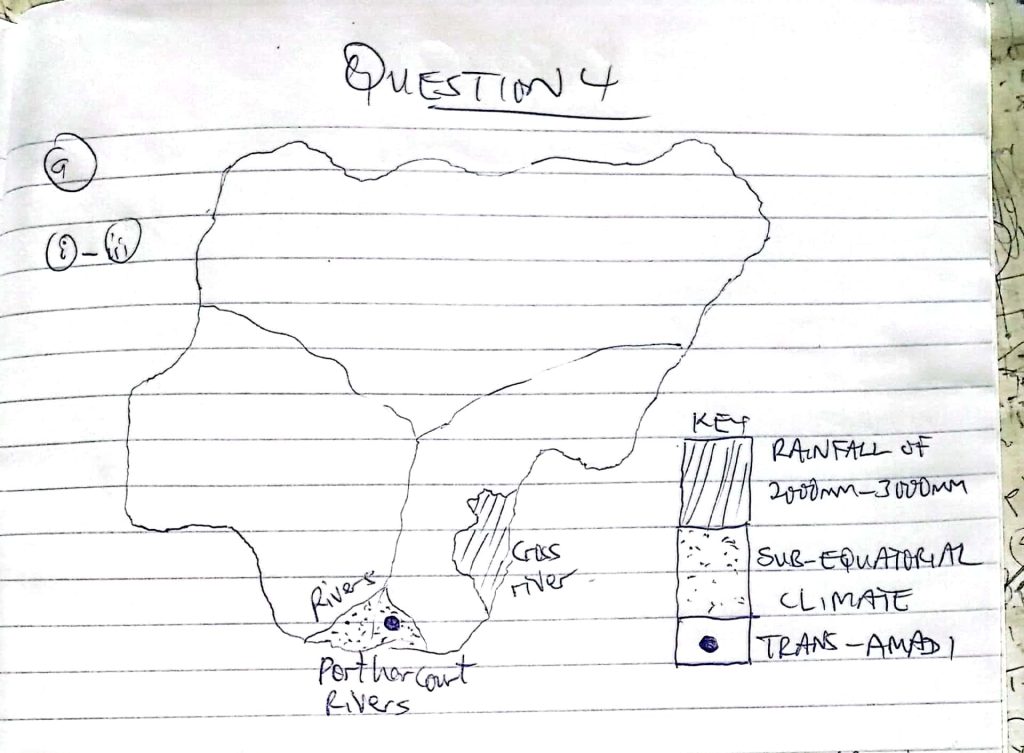WAEC Geography OBJ 2025
01-10: CBACBBBCCB
11-20: ABBDACCDBA
21-30: BBDCCCBADA
31-40: BABDABDBDA
41-50: CACACCACBD
COMPLETED!!!
WAEC Geography Essay 2025
Number 1
(1a)
(i)Rapid population growth: Developing countries often experience high rates of urbanization as people migrate from rural areas to cities in search of opportunities.
(ii)Informal settlements:
Due to rapid urbanization and lack of affordable housing, many urban areas in developing countries have a significant presence of informal settlements or slums.
(iii)Inadequate infrastructure: Urban areas in developing countries often struggle with inadequate infrastructure, including limited access to clean water, sanitation, electricity, and transportation.
(iv)High levels of unemployment and
poverty: Despite the opportunities that cities offer, many urban residents in developing countries face high levels of unemployment and poverty.
(v)Social and economic
inequalities: Urban areas in developing countries often exhibit significant social and economic inequalities, with disparities in access to resources, opportunities, and services.
(1b)
(i)Food supply: Urban areas depend on rural settlements for their food supply, as rural areas are often the primary producers of agricultural products.
(ii)Labor force: Rural areas often provide a labor force for urban industries and services, as people migrate from rural areas to cities in search of employment.
(iii)Natural resources: Urban areas depend on rural areas for natural resources, such as water, timber, and minerals.
(iv)Recreation and tourism: Rural areas often provide recreational and tourist opportunities for urban residents, offering a break from the hustle and bustle of city life.
Cultural and social
(v)connections: Urban areas often maintain cultural and social connections with surrounding rural areas, as many urban residents have family and cultural ties to rural communitie
==================
Number 2
(2a)
The balance of trade is the difference between a country’s total value of exports and its total value of imports over a specific period.
(2b)
(i)Demand for raw materials: Developed countries often require raw materials and agricultural products that are abundant in Tropical Africa.
(ii)Demand for manufactured goods: Tropical African countries often need manufactured goods and technologies that are produced in developed countries.
(iii)Investment: Foreign direct investment from developed countries can help boost production and trade in Tropical Africa.
(iv)Trade agreements: Trade agreements between Tropical African countries and developed countries can reduce trade barriers and promote trade.
(v)Transportation: Improvements in transportation infrastructure, such as ports and roads, can facilitate trade.
(2c)
(i)Increased economic growth: Trade can increase economic growth by allowing countries to specialize in the production of goods and services in which they have a comparative advantage.
(ii)Access to new markets: International trade provides access to new markets for Tropical African products, which can lead to increased sales and revenue.
(iii)Access to technology: International trade can provide access to new technologies and know-how, which can help to improve productivity and efficiency.
(iv)Job creation: International trade can create new jobs in export-oriented industries.
==================
Number 3
(3a)
Pipeline transportation is the method of transporting liquids and gases through a system of pipes from one location to another.
(3b)
(i) Crude oil
(ii) Natural gas
(3ci)
(i)Cost-Effective: Pipelines are a cost-effective way to transport large volumes of liquids and gases over long distances, reducing transportation costs compared to other methods.
(ii)Continuous Supply: Pipelines provide a continuous and reliable supply of resources, ensuring a steady flow of materials like oil and gas.
(iii)Environmentally Friendly: Compared to other modes like rail and oil ships, pipelines have a reduced environmental impact, especially when buried underground.
(iv)Reduced Traffic Congestion: Pipelines can help alleviate traffic congestion by reducing the need for trucks and other vehicles to transport goods.
(3cii)
(i)Vandalism and Theft: Pipelines are susceptible to vandalism and theft, which can lead to leaks, environmental damage, and economic losses.
(ii)High Initial Costs: Building pipelines requires significant upfront investment, which can be a barrier to development, especially in countries with limited resources.
(iii)Land Acquisition Challenges: Constructing pipelines often involves acquiring land, which can be difficult and lead to conflicts with local communities.
(iv)Maintenance and Repair: Pipelines require regular maintenance and repair, and failures can lead to disruptions in supply and environmental contamination.
==================
Number 4
(4a)

(4b)
(i)Latitude: Areas closer to the equator generally receive more rainfall than those further away.
(ii)Prevailing Winds: The direction and moisture content of winds influence rainfall patterns.
(iii)Altitude: Higher elevations tend to receive more rainfall than low-lying areas.
(iv)Distance from the Coast: Coastal regions receive more rainfall compared to inland areas.
(4c)
(i)High Rainfall: Sub-equatorial regions experience high annual rainfall, often exceeding 1500 mm.
(ii)High Temperatures: Temperatures are consistently high throughout the year.
(iii)Short Dry Season: The dry season is relatively short and less intense compared to other parts of Nigeria
==================
Number 5
(5a)
(i)Suitable Climate: Nigeria has a tropical climate with high rainfall and temperatures, ideal for cocoa growth.
(ii)Fertile Soil: The country has areas with well-drained, fertile soil that supports cocoa cultivation.
(iii)Traditional Farming Knowledge: Many farmers possess traditional knowledge of cocoa farming practices.
(iv) Government Support: Government initiatives, such as subsidies and training programs, encourage cocoa farming.
(v)Market Demand: Both local and international demand for cocoa beans provides an incentive for farmers to cultivate cocoa.
(5b)
(i)Pest and Disease Control: Implementing effective pest and disease management strategies can reduce crop losses.
(ii)Improved Farming Techniques: Training farmers on modern farming techniques, such as pruning and fertilization, can increase yields.
(iii)Access to Credit:
Providing farmers with access to loans and financial assistance can help them invest in their farms.
(iv)Infrastructure Development: Improving transportation infrastructure can facilitate the movement of cocoa beans to markets.
(v)Research and Development: Investing in research to develop high-yielding and disease-resistant cocoa varieties can boost production.
==================
Number 6

COMPLETED!!!
I want geography pratical questions
You are Welcomed
Thank so much
You are Welcomed